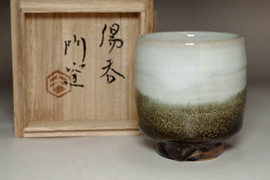Vintage mashiko ware tea cup #3986
- SKU:
- 3986
- Shipping:
- Free Shipping
- width: approx. 7.7cm (3 1⁄32in)
- height: approx. 9cm (3 35⁄64in)
- weight: 236g
Mashiko ware
It is generally agreed upon that Mashiko ware originated towards the end of the Edo period, in the year 1853 (Kaei 6). It was then that Keisaburo Otsuka, having learned the art of pottery in the city of Kasama, Ibaraki, traveled from what is now the town of Motegi, Tochigi to the town of Mashiko, where he discovered potter's clay and first lit his kiln.
The pottery industry continued to develop through the Meiji period, taking advantage of the bounties of the land to achieve Kanto-wide distribution of its wares. Around the same time, teapots decorated with simple landscape paintings were first created, and would go on to be produced in great numbers. Those teapots would later receive high praise from Hamada Shoji. However, towards the end of the Meiji period, as Tokyo (a major consumer of wares) modernized, the lifestyles of its residents began to change. This, combined with the rise of high-quality Kyo ware and the proliferation of rival Kasama ware, had a significant impact on Mashiko ware. This marked the beginning of a dark age for Mashiko.
After the Great Kanto Earthquake of 1923 (Taisho 12) struck Tokyo, Mashiko, which had been on the decline, received a new lease on life, thanks to the favorable economic conditions brought about by the earthquake. In the following year, Hamada Shoji, a master of the folk-art movement, established a pottery studio in Mashiko.
Awareness of Mashiko ware spread in concert with Hamada Shoji's fame. Finally, in 1955 (Showa 30), Hamada accepted a designation as a Living National Treasure for his exploits in the realm of folk pottery. Mashiko ware became known worldwide, and so the town of Mashiko came to achieve its current status and popularity among the general public.













